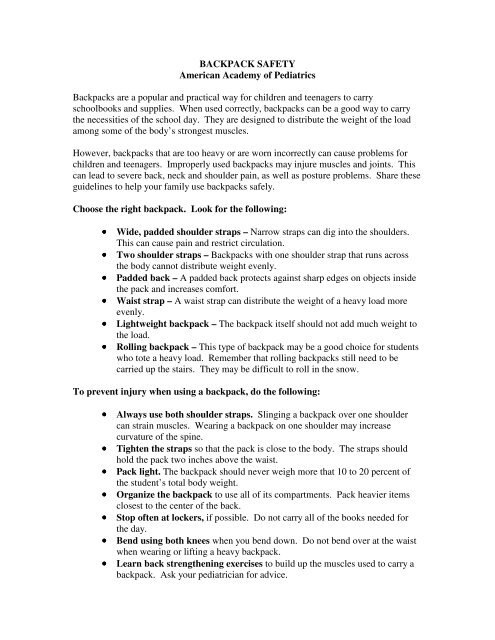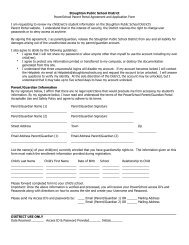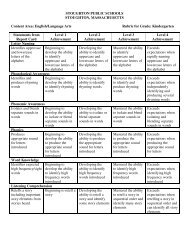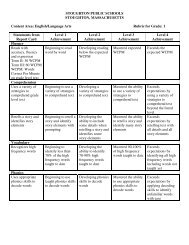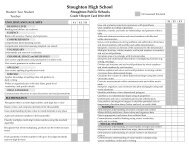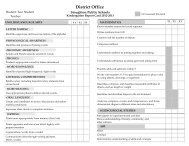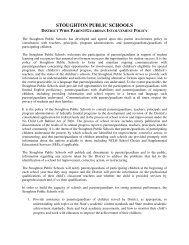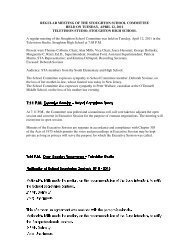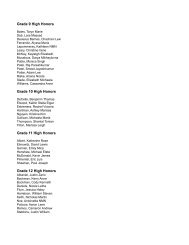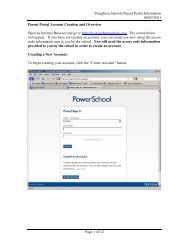BackPack Safety - Stoughton Public Schools
BackPack Safety - Stoughton Public Schools
BackPack Safety - Stoughton Public Schools
You also want an ePaper? Increase the reach of your titles
YUMPU automatically turns print PDFs into web optimized ePapers that Google loves.
BACKPACK SAFETYAmerican Academy of PediatricsBackpacks are a popular and practical way for children and teenagers to carryschoolbooks and supplies. When used correctly, backpacks can be a good way to carrythe necessities of the school day. They are designed to distribute the weight of the loadamong some of the body’s strongest muscles.However, backpacks that are too heavy or are worn incorrectly can cause problems forchildren and teenagers. Improperly used backpacks may injure muscles and joints. Thiscan lead to severe back, neck and shoulder pain, as well as posture problems. Share theseguidelines to help your family use backpacks safely.Choose the right backpack. Look for the following:• Wide, padded shoulder straps – Narrow straps can dig into the shoulders.This can cause pain and restrict circulation.• Two shoulder straps – Backpacks with one shoulder strap that runs acrossthe body cannot distribute weight evenly.• Padded back – A padded back protects against sharp edges on objects insidethe pack and increases comfort.• Waist strap – A waist strap can distribute the weight of a heavy load moreevenly.• Lightweight backpack – The backpack itself should not add much weight tothe load.• Rolling backpack – This type of backpack may be a good choice for studentswho tote a heavy load. Remember that rolling backpacks still need to becarried up the stairs. They may be difficult to roll in the snow.To prevent injury when using a backpack, do the following:• Always use both shoulder straps. Slinging a backpack over one shouldercan strain muscles. Wearing a backpack on one shoulder may increasecurvature of the spine.• Tighten the straps so that the pack is close to the body. The straps shouldhold the pack two inches above the waist.• Pack light. The backpack should never weigh more that 10 to 20 percent ofthe student’s total body weight.• Organize the backpack to use all of its compartments. Pack heavier itemsclosest to the center of the back.• Stop often at lockers, if possible. Do not carry all of the books needed forthe day.• Bend using both knees when you bend down. Do not bend over at the waistwhen wearing or lifting a heavy backpack.• Learn back strengthening exercises to build up the muscles used to carry abackpack. Ask your pediatrician for advice.
Parents can also help in the following ways:• Encourage your child or teenager to tell you about pain or discomfort that maybe caused by a heavy backpack. Do not ignore any back pain in a child orteenager. Ask you pediatrician for advice• Talk to the school about lightening the load. Be sure the school allowsstudents to stop at their lockers throughout the day. Team up with otherparents to encourage changes.• Consider buying an extra set of textbooks for your student to keep at home.The information contained in this publication should not be used as a substitute for themedical care and advice of your pediatrician. There may be a variation in treatment thatyour pediatrician may recommend based on individual facts and circumstances.Reprinted with the permission of the American Academy of Pediatrics.


